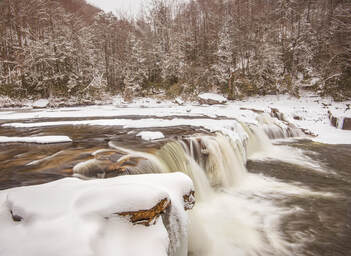
Despite its generic name, the High Falls of Cheat is known as one of Monongahela's more distinctive waterfalls. As less than 20 feet in height, the falls isn't very tall - but its signature feature is its width, stretching across a 100-foot wide cliff. The enormous pool and swimming hole denoting the base of High Falls is a welcome sight on a warm summer day. A scenic trail leads to the falls across Shavers Mountain from the West Fork Glady Fork valley. High Falls is unusual in that it is one of the longest waterfall hikes in Monongahela, yet it is also easily accessible by a scenic tourist train ride from Elkins. The Durbin and Greenbrier Valley Railroad Company runs a seasonal track through the Tygart Valley and up the remote gorge of the Shavers Fork Cheat River, otherwise accessible only by foot. The track runs directly past High Falls, so during the summer, don't be surprised to find company from people who reached the falls by train. On the other hand, you're likely to have the hike and falls all to yourself in the cold winter months, especially if you choose to visit after a foot of fresh snow has fallen, like I did. This hike occurred on Monday, February 1st, 2021. My plan was to simply hike the High Falls Trail out and back from the trailhead along FS 44.
1 Comment

The Endless Wall Trail is one of the most famous trails in New River Gorge National Park and all of West Virginia. Following the brink of the gorge for nearly two miles, the trail provides many outstanding views looking down from the towering cliffs of the Endless Wall. None is as legendary as Diamond Point, a rock promontory that features unobstructed views in both directions of the New River Gorge. However, what is less common knowledge is that the Endless Wall Trail serves as an access point to a set of spectacular off-trail waterfalls on Fern Creek. The trail crosses a placid Fern Creek above the gorge rim, but few people realize that a plethora of awe-striking beauty lies downstream. A side trail off the Endless Wall Trail known as the Climbers' Trail descends into the gorge through a series of ladders and caves, providing relatively easy access to Matteus Falls and Upper Fern Creek Falls. But reaching the middle and lower waterfalls of Fern Creek is a true adventure that is devoid of any paths, full of expansive rock gardens, and punctuated by house-size boulders. This trip report is split into two sections: the first describes the Fern Creek waterfall excursion, and the second describes the rest of the easy Endless Wall Trail. I initially hiked the Endless Wall Trail on Saturday, August 1st, 2020. I then returned to the area and explored the entirety of Fern Creek from top to bottom on Sunday, January 17th, 2021. This trip report combines details and photos from both hikes.
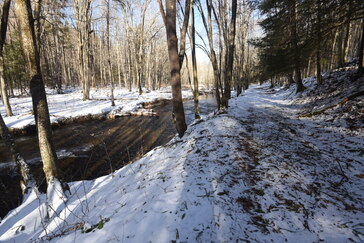
The Laurel Fork Wilderness is one of the least-travelled areas in Monongahela National Forest. The wilderness spans the length of the Laurel Fork of the Cheat River, an impressive waterway that winds through a remote area of the mountains east of the unincorporated community of Glady. You won't find any spectacular vistas or towering cascades here, but what you will find is a pristine river and a lovely (albeit sometimes faint) trail where solitude is guaranteed. The Laurel Fork Wilderness has been split into two halves by CR 40/FR 423, which crosses Laurel Fork at the Laurel Fork Campground. The report below describes an exploratory foray into the Laurel Fork North Wilderness. This hike occurred on Tuesday, January 12th, 2021. Starting at the campground, I traced the Laurel River Trail downstream through the broadening Laurel Fork valley to a junction with the Stone Camp Run Trail, and I then returned the same way.
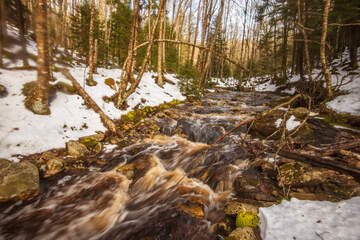
The Tea Creek Wildlife Management Area is the little, less intimidating brother to the better-known Cranberry Wilderness. Located just northeast of the Cranberry Wilderness on the other side of the Williams River, the Tea Creek area features dozens of miles of hiking trails with many of the same rushing creeks and dark spruce forests. Unlike the Cranberry Wilderness, all trails in Tea Creek WMA are well-marked and easier to follow. The loop described here is a very nice introduction to the area, traversing a myriad of ecosystems across the headwaters of Right Fork Tea Creek. The hike begins in the vast Tea Creek Meadows alongside Highlands Scenic Highway and follows first Right Fork Tea Creek and then Red Run for the first several miles, passing along beaver-formed wetlands and through rock gardens. The return route traces a relaxing old logging grade along the higher and drier slopes of Gauley Mountain. This hike occurred on January 2nd, 2021. My plan was to hike the Right Fork Trail from Tea Creek Meadows to the Red Run Trail. I then followed the Red Run Trail to the Gauley Mountain Trail, and I took the Gauley Mountain Trail back toward Tea Creek Meadows. I closed off the loop along the Right Fork Connector Trail and exited via the Tea Meadows Interpretive Trail.
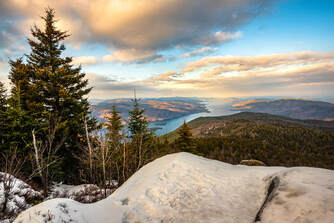
Towering over 2,000 feet above the east shore of Lake George is the little-known summit of Black Mountain. Given the fantastic views of Lake George and vicinity that Black Mountain provides both northward and southward, it is a wonder that this hike tends to stay so under-represented in the hiking community. Pike Brook Road serves as the starting point of the Black Mountain Trail, which reaches the summit in 2.5 miles with a remarkably well-graded climb. What's more, the full 7-mile loop drops down the back side of Black Mountain past multiple additional vistas before an exceptionally scenic traverse past Black Mountain Pond, Round Pond, and Lapland Pond. The Black Mountain Loop is definitely one of the highlight hikes of the Lake George area. Furthermore, this hike is a great winter pick for less experienced snowshoers, thanks to the trail's moderate grades and lack of the rock scrambling so typical to other parts of the Adirondack Park. This hike occurred on Tuesday, November 26th, 2019. My plan was to hike the Black Mountain Loop in a counter-clockwise direction from Pike Brook Road.
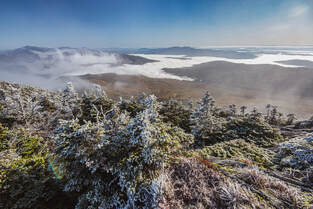
One of the most distinctive landmarks in Vermont and the third-tallest peak in the state, the rocky, alpine dome of 4,085-foot Camel's Hump is known well for its incredible 360-degree views overlooking a lengthy swath of the Green Mountains, with Lake Champlain, the Adirondacks, and the Whites all in view. Although Long Trail - Vermont's own long-distance trail - directly crosses the summit, getting there is still a steep, strenuous ascent from any direction. What some people fail to realize though is that Camel's Hump is just one highlight of the Long Trail as it runs south to Highway 17. The 11.7-mile section of the Long Trail between Camel's Hump and Appalachian Gap is never dull, featuring a variety of overlooks, spectacular bluffs, intricate rock mazes, bogs, and the signature viewpoint atop Burntrock Mountain. Expect this to be a difficult and slow hike that will take all day and test your physical shape. This hike occurred on Saturday, October 5th, 2019. My plan was to leave two cars - one at Appalachian Gap on Hwy 17 and one at the Burrows Trailhead - and start ascending the Burrows Trail to Camel's Hump. I would join the Long Trail near the summit, and I'd follow the Long Trail the rest of the day to Appalachian Gap.
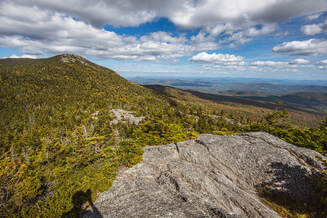
Situated just east of the town of Stowe in Northern Vermont, the Worcester Range is an elongated ridge of rocky peaks that seems to stay under the radar as a hiking destination for two very simple reasons: it isn't part of the famous Long Trail's route, and there are no 4000-foot peaks, which are frequently the primary focus of New Englanders' outdoor explorations. The Skyline Trail runs along the spine of the range and connects its two most prominent peaks: Mount Worcester and Mount Hunger. Not having the time for an ambitious exploration of the full ridge, I settled for a hike that looped around the south end, visiting Mount Hunger and its impressive subpeak Whiterock Mountain. Featuring multiple rock scrambles and 360-degree panoramic views that include some of Vermont's most iconic landmarks like Camel's Hump and Mount Mansfield, this is an incredible hike that has definitely stayed underappreciated. This hike occurred on Saturday, September 21st, 2019. My plan was to climb Mount Hunger via the Middlesex Trail and then descend via the Bob Kemp Trail, making the side trip to Whiterock Mountain along the way.
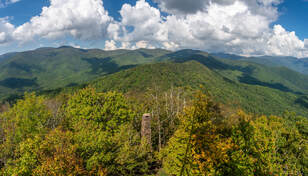
Twentymile is the southwesternmost major access point to Great Smoky Mountains National Park, and also one of the quietest. With nothing but a sleepy ranger station, small parking area, and trailhead, plus no significant destinations in close proximity, the Twentymile area remains little-visited compared to areas of the park like Cades Cove and Roaring Fork. Yet those who are willing to hike longer will find the Twentymile area quite interesting. The lengthy loop described here first follows the scenic cascades of Twentymile Creek before climbing to the Appalachian Trail and reaching the historic Shuckstack fire tower with its birds-eye view of Fontana Lake. The hike then heads deeper into the Smokies backcountry, traversing the Gregory Bald Trail - the eastern section of which near Doe Knob is one of the least-hiked trails in the park - before reaching the open grassy summit of Gregory Bald, featuring stunning 360-degree views. Even though both Shuckstack Tower and Gregory Bald can be reached via separate shorter hikes, it's hard to beat combining these two spectacular destinations into one large loop. This hike occurred on Saturday, October 6th, 2018. My plan was to initially hike the Twentymile Trail to the Appalachian Trail. After a side trip to Shuckstack, I would follow the AT north to Doe Knob. There, I'd pick up the Gregory Bald Trail and follow it all the way to Gregory Bald. On the other side of Gregory Bald, I would take the Wolf Ridge Trail and descend back to Twentymile. Although I completed this hike as a long day hike, you may find it more enjoyable as a two- or even three-day backpacking trip.
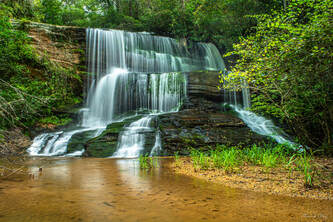
The Fall Creek watershed feeding into the Chattooga River in Oconee County, South Carolina, houses a trifecta of attractive yet lesser-known waterfalls that make for a wonderful half-day trip to access. Andrew Ramey Falls, a 30-foot cascading drop, is just a few hundred feet from Fall Creek Road down an obscure scramble path. The little-hiked pathway becomes more intimate and faint following Andrew Ramey Falls, but it stays easy enough to follow - if one pays attention - all the way to the spectacular sights at Pristine Falls and Falls Creek Falls. If you have the extra energy, you have the extra option of continuing an extra one-tenth of a mile down to the Chattooga River for a refreshing swim. Furthermore, solitude is essentially guaranteed on this trek! This hike occurred on Saturday, September 29th, 2018. My plan was to hike out and back to Andrew Ramey Falls, Pristine Falls, and Falls Creek Falls.
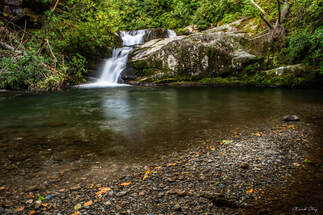
Imagine a large mountain waterway winding its way through a wilderness for nearly a dozen miles with zero road access. Picture a rugged, little-traveled pathway following this waterway, crisscrossing the creek many times through deep, slick fords, circumnavigating countless blowdowns and rock scrambles. There, you've discovered the Slickrock Creek Trail! This is the best creek trail I've ever walked in the Southern Appalachian Mountains, and I'm not even exaggerating. Nowhere else have I found a combination of such remote beauty and rugged wilderness trail, which never follows any of the logging roads customary to most North Carolina waterways. As if you needed more incentive to tackle this hike, the Slickrock Creek Trail features two secluded waterfalls - Wildcat Falls and Lower Falls - with swimming holes that couldn't be any more refreshing after a long summer day in the backcountry. This hike occurred on Saturday, September 15th, 2018. My plan was to day hike a lengthy loop through the heart of the Joyce Kilmer-Slickrock Creek Wilderness backcountry. I would start off along the Slickrock Creek Trail at Cheoah Dam along US 129, but before long, I would take the Ike Branch Trail. At Yellowhammer Gap, I would pick up the Yellowhammer Gap Trail, followed by the Nichols Cove Trail and Windy Gap Trail. The Windy Gap Trail would finally bring me to Slickrock Creek, from where I'd spend the rest of the day tracing the Slickrock Creek Trail back to US 129.
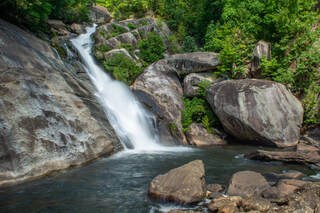
There's the touristy side of the Horsepasture River. There's the monster Rainbow Falls and its sidekicks, Stairway Falls, Turtleback Falls, and Drift Falls, all some of Gorges State Park's most popular and highly-regarded destinations. And then there's Windy Falls... the Horsepasture's truly wild side, tackled only by the most hardcore waterfallers and rock climbers. The Horsepasture's other waterfalls pale in comparison in the mighty shadow of Windy Falls, which crashes over 200 vertical feet through a conglomerate of boulders the sizes of two-story houses and slanted cliffs the sizes of small football fields. Those who reach this monster waterfall's base will be rewarded with a first-rate view of raw, breathtaking power, dwarfed by the even more majestic rocky surroundings. Yet reaching the base is an adventure not to be taken lightly, involving two rock scrambles with ropes and a squeeze through a keyhole perfect for getting stuck if you're larger than the average person. Gorges State Park neither sanctions nor recommends the trip to Windy Falls, and neither do I. Only people with substantial experience in cross-country rock scrambling with ropes must attempt to reach the base; those who don't could get injured or even fall to their deaths. Proceed at your own risk. This hike occurred on Saturday, September 8th, 2018. My plan was to hike out and back to the base of Windy Falls using a steep, unofficial trail from Chestnut Mountain Road concluding in a series of technical and potentially dangerous rock scrambles.
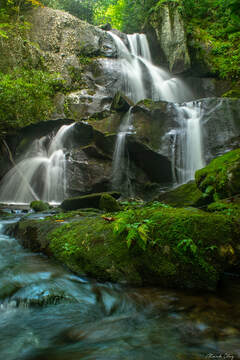
Nestled between the Little Tennessee River and the Cherohala Skyway, the 16,226-acre Citico Creek Wilderness features some of East Tennessee's most remote hiking trails. The primary focus points of the wilderness are its two major waterways: the North and South Forks of Citico Creek. Seldom-traveled trails follow both streams, crisscrossing them many times along the way, and providing numerous views of the creeks' many scenic cascades and pristine banks. Even better, a short scramble off the North Fork Trail is the spectacular Old Goat Falls, crashing 40 feet through a cleft amidst ferny cliffs. This hike, an ambitious loop along both forks of Citico Creek all the way to their headwaters, is among the best creek hikes in Cherokee National Forest. This hike occurred on Saturday, September 1st, 2018. My plan was to initially follow the South Fork Trail from Citico Creek Road to the North Fork Trail junction. There, I would pick up the North Fork Trail and climb it to Cherry Log Gap, scrambling down to Old Goat Falls along the way. I would then follow the Benton MacKaye Trail from Cherry Log Gap to Cold Spring Gap, from where I would take the South Fork Trail back to Citico Creek Road.

Silver Glen Springs is an oasis in the middle of Ocala National Forest, Florida's "big scrub". One of the forest's most scenic springs, Silver Glen Springs features strikingly transparent aquamarine waters that form a vivid contrast with the lush, tropical vegetation found along the shoreline. Not only is the spring a wonderful place to cool off on a scorching summer day, but it's also a natural aquarium, often housing hundreds of fish and even other species like the Atlantic stingray. A couple of nature trails branch out from the Silver Glen Springs Recreation Area. The Springs Boil Trail leads to a secondary spring called Jody's Spring, known for its many unique sand boils, nestled in the deep shade of a tropical hammock. The Lake George Trail meanders through uplands near Silver Glen Springs Run for a mile before reaching the shoreline of Lake George, Florida's second largest freshwater lake, so massive that it almost seems to be a sea. This hike occurred on Tuesday, August 28th, 2018. My plan was to hike both the Springs Boil Trail and Lake George Trail after exploring Silver Glen Springs.
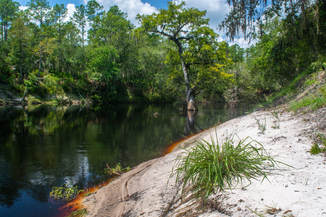
One of Florida's most attractive rivers valleys, the Suwannee River Valley has got it all: majestic bluffs, sandy beaches, tight and intricate tributaries, colorful springs, a surprising variety in elevation, and best of all, a 75-mile segment of the Florida Trail. The FT section between Camp Branch and Swift Creek - two special Suwannee feeder streams - is a true North Florida classic, showcasing most of the sights that make hiking along the Suwannee so wonderful. Even before you reach the Suwannee, you'll submerge into an unusual landscape, where the clear-bottomed Camp Branch (also known as Disappearing Creek) twists through a limestone chasm before vanishing into a dark sink, only to pop out at the Suwannee itself. From there, you'll pick up the Florida Trail, passing one gorgeous vista after another of the Suwannee River, crossing numerous scenic side streams like Jerry Branch, and scrambling through surprisingly deep ravines and up pointed hills. After close to 9 miles of hiking, you'll finally reach the hike's destination: Swift Creek, a lovely, cascading stream that dashes through Florida's version of the Grand Canyon before emptying into the Suwannee by an imposing limestone bluff. This hike occurred on Saturday, August 25th, 2018. My plan was to hike the blue-blazed FT access trail from the Camp Branch Trailhead to the Suwannee River (tracing the short Camp Branch Loop along the way), where I'd pick up the Florida Trail and follow it all the way to Swift Creek.
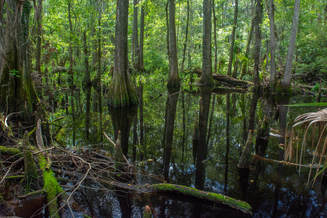
The Florida Trail section in the Rice Creek Conservation Area a few miles outside Palatka is short but truly unique and special. This hike dives right into the Rice Creek Swamp, the headwaters of Rice Creek - a major tributary of the St. Johns River. Back in the 19th century, the Rice Creek headwaters were actually a rice and indigo plantation. But today, the area is heavily wooded, and the only remaining traces of the past are the numerous levees crisscrossing the swamp. The Florida Trail loop utilizes several of these levees to provide a first-hand swamp experience. At the same time, the levees and an extraordinary system of boardwalks and footlogs allows you to keep your feet dry onto your journey into the swamp. You might even see a few gators or otters if you're lucky. A particularly remarkable point of interest along the Rice Creek section of the Florida Trail is Hoffman's Crossing - a slim boardwalk, 1,886 feet long, that crosses a branch of the swamp. This hike occurred on Wednesday, August 22nd, 2018. My plan was to hike the Rice Creek Loop from the Highway 100 Trailhead. Along the way, I'd extend my hike along the Florida Trail to see Hoffman's Crossing.
|
About MeMark Oleg Ozboyd Dear readers: I have invested a tremendous amount of time and effort in this website and the Georgia Waterfalls Database the past five years. All of the work that has gone in keeping these websites updated with my latest trip reports has almost been like a full-time job. This has not allowed me to pick up a paid job to save up money for college, and therefore, I I've had to take out loans. If you find the information on this website interesting, helpful, or time-saving, you can say "thanks" and help me out by clicking the button above and making a contribution. I will be very grateful for any amount of support you give, as all of it will apply toward my college tuition. Thank you!
Coming in 2022-2023?
Other Hiking WebsitesMiles HikedYear 1: 540.0 Miles
Year 2: 552.3 Miles Year 3: 518.4 Miles Year 4: 482.4 Miles Year 5: 259.9 Miles Archives
March 2021
Categories
All
|
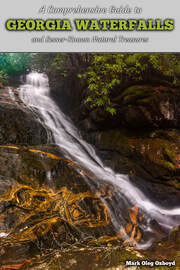
 RSS Feed
RSS Feed